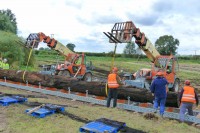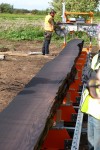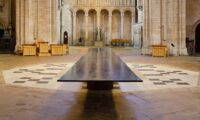Way back in the mists of 2012, farmers discovered a massive trunk of prehistoric oak preserved for 5,000  years in a Cambridgeshire peat bog. The trunk was 44 feet long and weighed five tons and it was only a section from the middle of the original oak, one of many Ent-like giants that ruled the Fenland Basin before rising levels turned the ancient high forest into a bog.
years in a Cambridgeshire peat bog. The trunk was 44 feet long and weighed five tons and it was only a section from the middle of the original oak, one of many Ent-like giants that ruled the Fenland Basin before rising levels turned the ancient high forest into a bog.
Bog oak is England’s only native black timber, prized for its rich color and thick stripe grain. Usually the finds are much more modest, however, and bog oak is used for inlays or smaller cabinetry. This giant was so huge and in such spectacular condition — no disease or parasites in life, almost no decomposition after death — that bog oak specialists decided the only way to do justice to its majesty was to saw it into planks the length of the entire trunk and create a massive table out of them that would go on public view.
 Thus the Fenland Black Oak Project was born. Dubbed the Jubilee Oak because it was discovered in the year of Queen Elizabeth II’s Diamond Jubilee, the oak was raised and quarter sawn into full-length planks. The planks were then dried in custom-built kilns 50 feet long. It took nine months to extract the water from the wood. A total of 1795 liters (474 gallons) of water was extracted; the planks lost half their thickness, a quarter of their width and 1.8 tons of weight.
Thus the Fenland Black Oak Project was born. Dubbed the Jubilee Oak because it was discovered in the year of Queen Elizabeth II’s Diamond Jubilee, the oak was raised and quarter sawn into full-length planks. The planks were then dried in custom-built kilns 50 feet long. It took nine months to extract the water from the wood. A total of 1795 liters (474 gallons) of water was extracted; the planks lost half their thickness, a quarter of their width and 1.8 tons of weight.
Designers then came up with an almost sculptural concept to show off this beautiful wood: a drop-leaf table mounted on a bronze understructure and four pilons for legs. The two outer planks are hinged to the bronze so they can be folded down. It’s even on wheels so this gigantic table can be moved easily by just two people. Craftspeople had to invent new techniques to manage planks of this size, including a whole new join known as the River Joint for its meandering shape.
The estimated time of completion was 2013. They turned out to be off by nine years. The table was completed in 2022, just in time for Queen Elizabeth’s II Platinum Jubilee. Inscriptions were added to opposite ends of the table marking its discovery in the Diamond Jubilee year and completion in the Platinum Jubilee year.
 The finished work found a suitably majestic setting for its enormousness in Ely Cathedral which was built on drained Fens, the same environment that saved the oak for so long, and is also the third longest medieval cathedral in England, so a perfect context for a 44-foot-long bog oak table. It has been placed on the stone floor under the Octagon Tower, a unique 14th century structure considered to be one of the masterpieces of medieval English architecture.
The finished work found a suitably majestic setting for its enormousness in Ely Cathedral which was built on drained Fens, the same environment that saved the oak for so long, and is also the third longest medieval cathedral in England, so a perfect context for a 44-foot-long bog oak table. It has been placed on the stone floor under the Octagon Tower, a unique 14th century structure considered to be one of the masterpieces of medieval English architecture.
The table was installed at Ely in May and will remain there for visitors to enjoy until March 2023.


I am pleased that the new site allows commenting. I wanted to comment months ago on this post.
Eley Cathedral is known for the timber construction of the roof and lantern on top of the central tower. Even when it was built, 700 years ago, oak trees large enough to do the job were difficult to find. It is said that none of that size are available today.
So it is appropriate that this large oak table be displayed there. I wish I could visit.
The table and the Cathedral are both testaments to the magnificence of England’s ancient forests. You are right. It is very fitting that the table should be shown there.
Thank you for coming back and commenting!